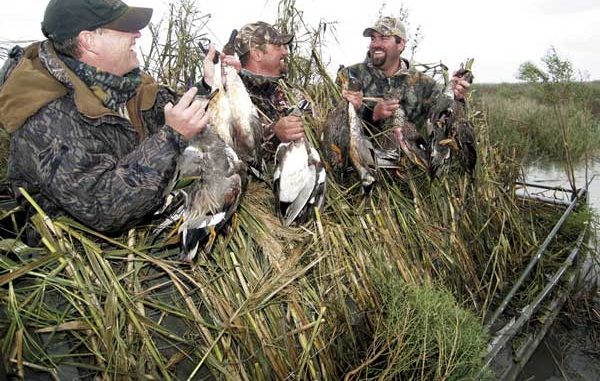
Get off the bank, and drop anchor in the middle of large lakes to greatly increase your duck harvest this winter.
In the beginning, Lloyd Landry was just like any other conscientious Louisiana duck hunter. He would study duck flights and feeding patterns in the Venice area, and set up his blind along primary flight corridors.
But when he decided to become a duck-hunting guide, he realized he would have to find a more consistent way to take ducks in the vast delta area.
Setting up along the shoreline worked early in the season, but no matter how good the location, ducks soon grew wary of the bank, and would fly just out of range and land in the middle of the water.
This problem was even worse in areas that held large numbers of ducks — like around the mouth of the Mississippi River.
“If you think about it, if there’s a thousand birds rafted in the middle, your 70-duck decoy spread can’t compete,” Landry said.
This didn’t fly when hunters were paying Landry to put them on the birds.
“I began hunting in the middle of the bays out of a boat blind 10 years ago,” Landry said. “I even hunted out of a mud-boat lined with shrubs in the ponds off of Texaco Canal (below Luling).”
Landry decided to get off the bank because, “as the seasoned progressed, the birds got spookier and spookier, and would start rafting up in the middle.”
When Landry began hunting the delta, he refined his technique until about five years ago; he began hunting out of a roomier barge blind complete with traveling greenery.
“We hunted the middle of Yellow Cotton Bay this way, but the last two years, we didn’t have any grass,” he said.
That’s not the case this year. The whole delta, including Yellow Cotton Bay, is slam-packed full of grass due to a stormless season and higher-than-normal Mississippi River.
“You ought to see the ducks we have right now,” he said in mid October. “We had so many pintails during teal season, it was stupid, and gadwalls and widgeon were everywhere.”
My husband, Louisiana Sportsman Publisher Tony Taylor, and I hunted with Landry in Venice’s Bay Denesse on a blustery, dreary January day last season. Landry launched his 21-foot Skeeter bay boat at Fort Jackson, crossed the river and motored to where his Go-Devil barge was parked near the public bay.
The Bay Denesse area was one of the few places along the coast that held ducks in 2006. The main problem with hunting them was that during the week, there were so few hunters that the ducks wouldn’t move unless the wind blew.
We didn’t have that problem; on the day we hunted, the wind was blustering at around 30 m.p.h. with occasional sheeting rain. Plus it was freezing cold, but well-insulated, waterproof Realtree HD waterfowl camouflage kept us surprisingly snug.
We finally settled in the middle of Bay Denesse by 8:30 a.m.
“A lot of times, we like to leave after daylight because it’s safer to cross the river, and we can see where the birds are rafted up. That’s where we go,” Landry said.
As soon as Landry and his brother, Luke Landry, got the decoys out, packs of birds started circling, and the action didn’t stop until we ran out of shells.
Unbelievably, these late-seasoned ducks reacted to our mid-lake decoys like they were long-lost family. Although it was almost the end of the season, they flew in like opening day.
If teal season is any indication, word of the Venice duck feast is spreading.
“There’s an abundance of hunters now,” said Landry. “But it’s all good. Everybody’s nice to each other.
“Besides, everyone else hunts on the bank. Only a few of us hunt in the middle.”
Capt. Lloyd Landry can be reached at 504-912-8291.